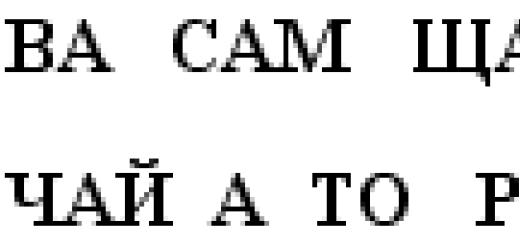Vieta's theorem is often used to test already found roots. If you have found the roots, you can use the formulas \(\begin(cases)x_1+x_2=-p \\x_1 \cdot x_2=q\end(cases)\) to calculate the values \(p\) and \(q\ ). And if they turn out to be the same as in the original equation, then the roots are found correctly.
For example, let's use , solve the equation \(x^2+x-56=0\) and get the roots: \(x_1=7\), \(x_2=-8\). Let's check if we made a mistake in the process of solving. In our case, \(p=1\), and \(q=-56\). By Vieta's theorem we have:
\(\begin(cases)x_1+x_2=-p \\x_1 \cdot x_2=q\end(cases)\) \(\Leftrightarrow\) \(\begin(cases)7+(-8)=-1 \\7\cdot(-8)=-56\end(cases)\) \(\Leftrightarrow\) \(\begin(cases)-1=-1\\-56=-56\end(cases)\ )
Both statements converged, which means that we solved the equation correctly.
This test can be done orally. It will take 5 seconds and save you from stupid mistakes.
Inverse Vieta theorem
If \(\begin(cases)x_1+x_2=-p \\x_1 \cdot x_2=q\end(cases)\), then \(x_1\) and \(x_2\) are the roots of the quadratic equation \(x^ 2+px+q=0\).
Or in a simple way: if you have an equation of the form \(x^2+px+q=0\), then by solving the system \(\begin(cases)x_1+x_2=-p \\x_1 \cdot x_2=q\ end(cases)\) you will find its roots.
Thanks to this theorem, you can quickly find the roots of a quadratic equation, especially if these roots are . This skill is important as it saves a lot of time.
Example . Solve the equation \(x^2-5x+6=0\).
Solution
: Using the inverse Vieta theorem, we get that the roots satisfy the conditions: \(\begin(cases)x_1+x_2=5 \\x_1 \cdot x_2=6\end(cases)\).
Look at the second equation of the \(x_1 \cdot x_2=6\) system. Into what two can the number \(6\) be decomposed? On \(2\) and \(3\), \(6\) and \(1\) or \(-2\) and \(-3\), and \(-6\) and \(- one\). And which pair to choose, the first equation of the system will tell: \(x_1+x_2=5\). \(2\) and \(3\) are similar, because \(2+3=5\).
Answer
: \(x_1=2\), \(x_2=3\).
Examples
. Using the inverse of Vieta's theorem, find the roots of the quadratic equation:
a) \(x^2-15x+14=0\); b) \(x^2+3x-4=0\); c) \(x^2+9x+20=0\); d) \(x^2-88x+780=0\).
Solution
:
a) \(x^2-15x+14=0\) - what factors does \(14\) decompose into? \(2\) and \(7\), \(-2\) and \(-7\), \(-1\) and \(-14\), \(1\) and \(14\ ). What pairs of numbers add up to \(15\)? Answer: \(1\) and \(14\).
b) \(x^2+3x-4=0\) - into what factors does \(-4\) decompose? \(-2\) and \(2\), \(4\) and \(-1\), \(1\) and \(-4\). What pairs of numbers add up to \(-3\)? Answer: \(1\) and \(-4\).
c) \(x^2+9x+20=0\) – into what factors does \(20\) decompose? \(4\) and \(5\), \(-4\) and \(-5\), \(2\) and \(10\), \(-2\) and \(-10\ ), \(-20\) and \(-1\), \(20\) and \(1\). What pairs of numbers add up to \(-9\)? Answer: \(-4\) and \(-5\).
d) \(x^2-88x+780=0\) - into what factors does \(780\) decompose? \(390\) and \(2\). Do they add up to \(88\)? No. What other multipliers does \(780\) have? \(78\) and \(10\). Do they add up to \(88\)? Yes. Answer: \(78\) and \(10\).
It is not necessary to decompose the last term into all possible factors (as in the last example). You can immediately check whether their sum gives \(-p\).
Important! Vieta's theorem and the converse theorem only work with , that is, one whose coefficient in front of \(x^2\) is equal to one. If we initially have a non-reduced equation, then we can make it reduced by simply dividing by the coefficient in front of \ (x ^ 2 \).
For example, let the equation \(2x^2-4x-6=0\) be given and we want to use one of Vieta's theorems. But we can't, because the coefficient before \(x^2\) is equal to \(2\). Let's get rid of it by dividing the whole equation by \(2\).
\(2x^2-4x-6=0\) \(|:2\)
\(x^2-2x-3=0\)
Ready. Now we can use both theorems.
Answers to frequently asked questions
Question:
By Vieta's theorem, you can solve any ?
Answer:
Unfortunately no. If there are not integers in the equation or the equation has no roots at all, then Vieta's theorem will not help. In this case, you need to use discriminant
. Fortunately, 80% of the equations in the school math course have integer solutions.
Quadratic function.
The function given by the formula y = ax2 + bx + c , where x and y are variables and a, b, c are given numbers, with a not equal to 0 .
called quadratic function
Selection of a full square.
Derivation of the formula for the roots of a quadratic equation, the conditions for their existence and numbers.

is the discriminant of the quadratic equation.
Vieta's direct and inverse theorems.
Decomposition of a square trinomial into linear factors.
Theorem. Let
x 1 and x 2 - roots of a square trinomialx 2 + px + q. Then this trinomial is decomposed into linear factors as follows:x 2 + px + q = (x - x 1) (x - x 2).Proof. Substitute instead of
p and qtheir expressions throughx 1 and x 2 and use the grouping method:x 2 + px + q = x 2 - (x 1 + x 2 ) x + x 1 x 2 = x 2 - x 1 x - x 2 x + x 1 x 2 = x (x - x 1 ) - x 2 (x - x 1 ) = = (x - x 1 ) (x - x 2 ). The theorem has been proven.
Quadratic equation. Square Trinomial Plot
Type equation
is called a quadratic equation. The number D = b 2 - 4ac is the discriminant of this equation.
If a
then the numbers

are the roots (or solutions) of the quadratic equation. If D = 0, then the roots coincide:
If D< 0, то квадратное уравнение корней не имеет.
Valid formulas:

- Vieta formulas; a
ax 2 + bx + c \u003d a (x - x 1) (x - x 2) -
factorization formula.
The graph of a quadratic function (square trinomial) y \u003d ax 2 + bx + c is a parabola. The location of the parabola depending on the signs of the coefficient a and the discriminant D is shown in fig.

The numbers x 1 and x 2 on the x-axis are the roots of the quadratic equation ax 2 + bx + + c \u003d 0; coordinates of the vertex of the parabola (point A) in all cases

the point of intersection of the parabola with the y-axis has coordinates (0; c).
Like a straight line and a circle, a parabola divides a plane into two parts. In one of these parts, the coordinates of all points satisfy the inequality y > ax 2 + bx + c, and in the other, the opposite. The inequality sign in the selected part of the plane is determined by finding it at some point in this part of the plane.
Consider the concept of a tangent to a parabola (or a circle). A line y - kx + 1 will be called a tangent to a parabola (or a circle) if it has one common point with this curve.

At the point of contact M(x; y) for the parabola, the equality kx + 1 = ax 2 + bx + c is fulfilled (for the circle, the equality (x - x 0) 2 + (kx + 1 - y 0) 2 - R 2). Equating the discriminant of the resulting quadratic equation to zero (since the equation must have a unique solution), we arrive at the conditions for calculating the coefficients of the tangent.
There are a number of relationships in quadratic equations. The main ones are the relations between roots and coefficients. Also, a number of relationships work in quadratic equations, which are given by the Vieta theorem.
In this topic, we present the Vieta theorem itself and its proof for a quadratic equation, a theorem converse to Vieta's theorem, and analyze a number of examples of solving problems. We will pay special attention in the material to the consideration of the Vieta formulas, which define the relationship between the real roots of the algebraic equation of degree n and its coefficients.
Yandex.RTB R-A-339285-1
Statement and proof of Vieta's theorem
The formula for the roots of a quadratic equation a x 2 + b x + c = 0 of the form x 1 \u003d - b + D 2 a, x 2 \u003d - b - D 2 a, where D = b 2 − 4 a c, establishes the ratio x 1 + x 2 \u003d - b a, x 1 x 2 = c a. This is confirmed by Vieta's theorem.
Theorem 1
In a quadratic equation a x 2 + b x + c = 0, where x 1 and x2- roots, the sum of the roots will be equal to the ratio of the coefficients b and a, which was taken with the opposite sign, and the product of the roots will be equal to the ratio of the coefficients c and a, i.e. x 1 + x 2 \u003d - b a, x 1 x 2 = c a.
Proof 1
We offer you the following scheme for conducting the proof: we take the formula of the roots, compose the sum and product of the roots of the quadratic equation and then transform the resulting expressions in order to make sure that they are equal -b a and c a respectively.
Compose the sum of the roots x 1 + x 2 \u003d - b + D 2 a + - b - D 2 a. Let's bring the fractions to a common denominator - b + D 2 · a + - b - D 2 · a = - b + D + - b - D 2 · a. Let's open the brackets in the numerator of the resulting fraction and give similar terms: - b + D + - b - D 2 a = - b + D - b - D 2 a = - 2 b 2 a . Reduce the fraction by: 2 - b a \u003d - b a.
So we have proved the first relation of Vieta's theorem, which refers to the sum of the roots of a quadratic equation.
Now let's move on to the second relation.
To do this, we need to compose the product of the roots of the quadratic equation: x 1 x 2 \u003d - b + D 2 a - b - D 2 a.
Recall the rule for multiplying fractions and write the last product as follows: - b + D · - b - D 4 · a 2 .
We will carry out the multiplication of the bracket by the bracket in the numerator of the fraction, or we will use the formula of the difference of squares in order to transform this product faster: - b + D · - b - D 4 · a 2 = - b 2 - D 2 4 · a 2 .
Let's use definition of a square root to carry out the following transition: - b 2 - D 2 4 · a 2 = b 2 - D 4 · a 2 . Formula D = b 2 − 4 a c corresponds to the discriminant of the quadratic equation, therefore, into a fraction instead of D can be substituted b 2 − 4 a c:
b 2 - D 4 a 2 \u003d b 2 - (b 2 - 4 a c) 4 a 2
Let's open the brackets, give like terms and get: 4 · a · c 4 · a 2 . If we shorten it to 4 a, then c a remains. So we have proved the second relation of the Vieta theorem for the product of roots.
The record of the proof of Vieta's theorem can have a very concise form, if we omit the explanations:
x 1 + x 2 \u003d - b + D 2 a + - b - D 2 a \u003d - b + D + - b - D 2 a \u003d - 2 b 2 a \u003d - b a, x 1 x 2 = - b + D 2 a - b - D 2 a = - b + D - b - D 4 a 2 = - b 2 - D 2 4 a 2 = b 2 - D 4 a 2 = = D = b 2 - 4 a c = b 2 - b 2 - 4 a c 4 a 2 = 4 a c 4 a 2 = c a .
When the discriminant of a quadratic equation is zero, the equation will have only one root. To be able to apply Vieta's theorem to such an equation, we can assume that the equation with a discriminant equal to zero has two identical roots. Indeed, at D=0 the root of the quadratic equation is: - b 2 a, then x 1 + x 2 \u003d - b 2 a + - b 2 a \u003d - b + (- b) 2 a \u003d - 2 b 2 a \u003d - b a and x 1 x 2 \u003d - b 2 a - b 2 a \u003d - b - b 4 a 2 \u003d b 2 4 a 2, and since D \u003d 0, that is, b 2 - 4 a c = 0, whence b 2 = 4 a c, then b 2 4 a 2 = 4 a c 4 a 2 = c a .
Most often in practice, the Vieta theorem is applied in relation to the reduced quadratic equation of the form x 2 + p x + q = 0, where the leading coefficient a is equal to 1 . In this regard, Vieta's theorem is formulated precisely for equations of this type. This does not limit the generality due to the fact that any quadratic equation can be replaced by an equivalent equation. To do this, it is necessary to divide both its parts by the number a, which is different from zero.
Let us give one more formulation of Vieta's theorem.
Theorem 2
The sum of the roots in the given quadratic equation x 2 + p x + q = 0 will be equal to the coefficient at x, which is taken with the opposite sign, the product of the roots will be equal to the free term, i.e. x 1 + x 2 \u003d - p, x 1 x 2 \u003d q.
Theorem inverse to Vieta's theorem
If you look closely at the second formulation of Vieta's theorem, you can see that for the roots x 1 and x2 reduced quadratic equation x 2 + p x + q = 0 relations x 1 + x 2 = − p , x 1 · x 2 = q will be valid. From these relations x 1 + x 2 \u003d - p, x 1 x 2 \u003d q, it follows that x 1 and x2 are the roots of the quadratic equation x 2 + p x + q = 0. Thus we arrive at a statement which is the inverse of Vieta's theorem.
We now propose to formalize this statement as a theorem and carry out its proof.
Theorem 3
If numbers x 1 and x2 are such that x 1 + x 2 = − p and x 1 x 2 = q, then x 1 and x2 are the roots of the reduced quadratic equation x 2 + p x + q = 0.
Proof 2
Change of coefficients p and q to their expression through x 1 and x2 allows you to transform the equation x 2 + p x + q = 0 in an equivalent .
If we substitute the number into the resulting equation x 1 instead of x, then we get the equality x 1 2 − (x 1 + x 2) x 1 + x 1 x 2 = 0. This equality for any x 1 and x2 turns into a true numerical equality 0 = 0 , because x 1 2 − (x 1 + x 2) x 1 + x 1 x 2 = x 1 2 − x 1 2 − x 2 x 1 + x 1 x 2 = 0. It means that x 1- root of the equation x 2 − (x 1 + x 2) x + x 1 x 2 = 0, and what x 1 is also the root of the equivalent equation x 2 + p x + q = 0.
Equation substitution x 2 − (x 1 + x 2) x + x 1 x 2 = 0 numbers x2 instead of x allows you to get equality x 2 2 − (x 1 + x 2) x 2 + x 1 x 2 = 0. This equality can be considered true, since x 2 2 − (x 1 + x 2) x 2 + x 1 x 2 = x 2 2 − x 1 x 2 − x 2 2 + x 1 x 2 = 0. It turns out that x2 is the root of the equation x 2 − (x 1 + x 2) x + x 1 x 2 = 0, and hence the equations x 2 + p x + q = 0.
The theorem converse to Vieta's theorem is proved.
Examples of using Vieta's theorem
Let's now proceed to the analysis of the most typical examples on the topic. Let's start with the analysis of problems that require the application of the theorem, the converse of Vieta's theorem. It can be used to check the numbers obtained in the course of calculations, whether they are the roots of a given quadratic equation. To do this, you need to calculate their sum and difference, and then check the validity of the ratios x 1 + x 2 = - b a, x 1 x 2 = a c.
The fulfillment of both relations indicates that the numbers obtained in the course of calculations are the roots of the equation. If we see that at least one of the conditions is not met, then these numbers cannot be the roots of the quadratic equation given in the condition of the problem.
Example 1
Which of the pairs of numbers 1) x 1 = - 5, x 2 = 3, or 2) x 1 = 1 - 3, x 2 = 3 + 3, or 3) x 1 = 2 + 7 2, x 2 = 2 - 7 2 is a pair of roots of the quadratic equation 4 x 2 − 16 x + 9 = 0?
Solution
Find the coefficients of the quadratic equation 4 x 2 − 16 x + 9 = 0 . This is a = 4 , b = − 16 , c = 9 . In accordance with the Vieta theorem, the sum of the roots of the quadratic equation must be equal to -b a, that is, 16 4 = 4 , and the product of the roots should be equal to c a, that is, 9 4 .
Let's check the obtained numbers by calculating the sum and product of numbers from three given pairs and comparing them with the obtained values.
In the first case x 1 + x 2 = - 5 + 3 = - 2. This value is different from 4 , so you don't need to continue checking. According to the theorem, the inverse of Vieta's theorem, we can immediately conclude that the first pair of numbers are not the roots of this quadratic equation.
In the second case x 1 + x 2 = 1 - 3 + 3 + 3 = 4. We see that the first condition is met. But the second condition is not: x 1 x 2 \u003d 1 - 3 3 + 3 \u003d 3 + 3 - 3 3 - 3 \u003d - 2 3. The value we got is different from 9 4 . This means that the second pair of numbers are not the roots of the quadratic equation.
Let's move on to the third pair. Here x 1 + x 2 = 2 + 7 2 + 2 - 7 2 = 4 and x 1 x 2 = 2 + 7 2 2 - 7 2 = 2 2 - 7 2 2 = 4 - 7 4 = 16 4 - 7 4 = 9 4 . Both conditions are satisfied, which means that x 1 and x2 are the roots of the given quadratic equation.
Answer: x 1 \u003d 2 + 7 2, x 2 \u003d 2 - 7 2
We can also use the inverse of Vieta's theorem to find the roots of a quadratic equation. The easiest way is to select integer roots of the given quadratic equations with integer coefficients. Other options may also be considered. But this can significantly complicate the calculations.
To select the roots, we use the fact that if the sum of two numbers is equal to the second coefficient of the quadratic equation, taken with a minus sign, and the product of these numbers is equal to the free term, then these numbers are the roots of this quadratic equation.
Example 2
As an example, we use the quadratic equation x 2 − 5 x + 6 = 0. Numbers x 1 and x2 can be the roots of this equation if the two equalities are satisfied x1 + x2 = 5 and x 1 x 2 = 6. Let's pick those numbers. These are the numbers 2 and 3 because 2 + 3 = 5 and 2 3 = 6. It turns out that 2 and 3 are the roots of this quadratic equation.
The inverse of Vieta's theorem can be used to find the second root when the first is known or obvious. For this we can use the ratios x 1 + x 2 = - b a , x 1 · x 2 = c a .
Example 3
Consider the quadratic equation 512 x 2 - 509 x - 3 = 0. We need to find the roots of this equation.
Solution
The first root of the equation is 1 because the sum of the coefficients of this quadratic equation is zero. It turns out that x 1 = 1.
Now let's find the second root. To do this, you can use the ratio x 1 x 2 = c a. It turns out that 1 x 2 = − 3 512, where x 2 \u003d - 3 512.
Answer: the roots of the quadratic equation specified in the condition of the problem 1 and - 3 512 .
It is possible to select roots using the theorem converse to Vieta's theorem only in simple cases. In other cases, it is better to search using the formula of the roots of the quadratic equation through the discriminant.
Thanks to the converse theorem of Vieta, we can also form quadratic equations given the roots x 1 and x2. To do this, we need to calculate the sum of the roots, which gives the coefficient at x with the opposite sign of the reduced quadratic equation, and the product of the roots, which gives the free term.
Example 4
Write a quadratic equation whose roots are numbers − 11 and 23 .
Solution
Let's accept that x 1 = − 11 and x2 = 23. The sum and product of these numbers will be equal to: x1 + x2 = 12 and x 1 x 2 = − 253. This means that the second coefficient is 12, the free term − 253.
We make an equation: x 2 - 12 x - 253 = 0.
Answer: x 2 - 12 x - 253 = 0 .
We can use the Vieta theorem to solve problems that are related to the signs of the roots of quadratic equations. The connection between Vieta's theorem is related to the signs of the roots of the reduced quadratic equation x 2 + p x + q = 0 in the following way:
- if the quadratic equation has real roots and if the free term q is a positive number, then these roots will have the same sign "+" or "-";
- if the quadratic equation has roots and if the free term q is a negative number, then one root will be "+" and the second "-".
Both of these statements are a consequence of the formula x 1 x 2 = q and multiplication rules for positive and negative numbers, as well as numbers with different signs.
Example 5
Are the roots of a quadratic equation x 2 - 64 x - 21 = 0 positive?
Solution
By Vieta's theorem, the roots of this equation cannot both be positive, since they must satisfy the equality x 1 x 2 = − 21. This is not possible with positive x 1 and x2.
Answer: Not
Example 6
At what values of the parameter r quadratic equation x 2 + (r + 2) x + r − 1 = 0 will have two real roots with different signs.
Solution
Let's start by finding the values of what r, for which the equation has two roots. Let us find the discriminant and see for what r it will take positive values. D = (r + 2) 2 − 4 1 (r − 1) = r 2 + 4 r + 4 − 4 r + 4 = r 2 + 8. Expression value r2 + 8 positive for any real r, therefore, the discriminant will be greater than zero for any real r. This means that the original quadratic equation will have two roots for any real values of the parameter r.
Now let's see when the roots will have different signs. This is possible if their product is negative. According to the Vieta theorem, the product of the roots of the reduced quadratic equation is equal to the free term. So the correct solution is those values r, for which the free term r − 1 is negative. We solve the linear inequality r − 1< 0 , получаем r < 1 .
Answer: at r< 1 .
Vieta formulas
There are a number of formulas that are applicable for performing operations with roots and coefficients of not only square, but also cubic and other types of equations. They are called Vieta formulas.
For an algebraic equation of degree n of the form a 0 · x n + a 1 · x n - 1 + . . . + a n - 1 x + a n = 0 the equation is considered to have n real roots x 1 , x 2 , … , x n, which may include the following:
x 1 + x 2 + x 3 + . . . + x n \u003d - a 1 a 0, x 1 x 2 + x 1 x 3 +. . . + x n - 1 x n = a 2 a 0 , x 1 x 2 x 3 + x 1 x 2 x 4 + . . . + x n - 2 x n - 1 x n = - a 3 a 0 , . . . x 1 x 2 x 3 . . . x n = (- 1) n a n a 0
Definition 1
Get the Vieta formulas help us:
- theorem on decomposition of a polynomial into linear factors;
- definition of equal polynomials through the equality of all their corresponding coefficients.
So, the polynomial a 0 x n + a 1 x n - 1 + . . . + a n - 1 · x + a n and its expansion into linear factors of the form a 0 · (x - x 1) · (x - x 2) · . . . · (x - x n) are equal.
If we open the brackets in the last product and equate the corresponding coefficients, then we get the Vieta formulas. Taking n \u003d 2, we can get the Vieta formula for the quadratic equation: x 1 + x 2 \u003d - a 1 a 0, x 1 x 2 \u003d a 2 a 0.
Definition 2
Vieta's formula for a cubic equation:
x 1 + x 2 + x 3 = - a 1 a 0, x 1 x 2 + x 1 x 3 + x 2 x 3 = a 2 a 0, x 1 x 2 x 3 = - a 3 a 0
The left side of the Vieta formulas contains the so-called elementary symmetric polynomials.
If you notice a mistake in the text, please highlight it and press Ctrl+Enter
The essence of this technique is to find the roots without the help of the discriminant. For an equation of the form x2 + bx + c = 0, where there are two real different roots, two statements are true.The first statement says that the sum of the roots of this equation is equal to the value of the coefficient of the variable x (in this case it is b), but with the opposite sign. Visually, it looks like this: x1 + x2 = −b.
The second statement is no longer connected with the sum, but with the product of the same two roots. This product is equated to a free coefficient, i.e. c. Or, x1 * x2 = c. Both of these examples are solved in the system.
Vieta's theorem greatly simplifies the solution, but has one limitation. A quadratic equation whose roots can be found using this technique must be reduced. In the above equation for the coefficient a, the one before x2 is equal to one. Any equation can be reduced to a similar form by dividing the expression by the first coefficient, but this operation is not always rational.
Proof of the theorem
To begin with, we should remember how, according to tradition, it is customary to look for the roots of a quadratic equation. The first and second roots are found, namely: x1 = (-b-√D)/2, x2 = (-b+√D)/2. Generally divisible by 2a, but, as already mentioned, the theorem can only be applied when a=1.It is known from Vieta's theorem that the sum of the roots is equal to the second coefficient with a minus sign. This means that x1 + x2 = (-b-√D)/2 + (-b+√D)/2 = −2b/2 = −b.
The same is true for the product of unknown roots: x1 * x2 = (-b-√D)/2 * (-b+√D)/2 = (b2-D)/4. In turn, D = b2-4c (again, with a=1). It turns out that the result is: x1 * x2 = (b2- b2)/4+c = c.
From the above simple proof, only one conclusion can be drawn: Vieta's theorem is completely confirmed.
Second formulation and proof
Vieta's theorem has another interpretation. To be more precise, it is not an interpretation, but a wording. The fact is that if the same conditions are met as in the first case: there are two different real roots, then the theorem can be written in a different formula.This equality looks like this: x2 + bx + c = (x - x1)(x - x2). If the function P(x) intersects at two points x1 and x2, then it can be written as P(x) = (x - x1)(x - x2) * R(x). In the case when P has the second degree, and this is exactly what the original expression looks like, then R is a prime number, namely 1. This statement is true for the reason that otherwise the equality will not hold. The coefficient x2 when opening brackets should not be more than one, and the expression should remain square.
One of the methods for solving a quadratic equation is the application VIETA formulas, which was named after FRANCOIS VIETE.
He was a famous lawyer, and served in the 16th century with the French king. In his free time he studied astronomy and mathematics. He established a connection between the roots and coefficients of a quadratic equation.
Advantages of the formula:
1 . By applying the formula, you can quickly find the solution. Because you do not need to enter the second coefficient into the square, then subtract 4ac from it, find the discriminant, substitute its value into the formula for finding the roots.
2 . Without a solution, you can determine the signs of the roots, pick up the values of the roots.
3 . Having solved the system of two records, it is not difficult to find the roots themselves. In the above quadratic equation, the sum of the roots is equal to the value of the second coefficient with a minus sign. The product of the roots in the above quadratic equation is equal to the value of the third coefficient.
4 . According to the given roots, write a quadratic equation, that is, solve the inverse problem. For example, this method is used in solving problems in theoretical mechanics.
5 . It is convenient to apply the formula when the leading coefficient is equal to one.
Flaws:
1
. The formula is not universal.
Vieta's theorem Grade 8
Formula
If x 1 and x 2 are the roots of the given quadratic equation x 2 + px + q \u003d 0, then:

Examples
x 1 \u003d -1; x 2 \u003d 3 - the roots of the equation x 2 - 2x - 3 \u003d 0.
P = -2, q = -3.
X 1 + x 2 \u003d -1 + 3 \u003d 2 \u003d -p,
X 1 x 2 = -1 3 = -3 = q.
Inverse theorem
Formula
If the numbers x 1 , x 2 , p, q are connected by the conditions:

Then x 1 and x 2 are the roots of the equation x 2 + px + q = 0.
Example
Let's make a quadratic equation by its roots:
X 1 \u003d 2 -? 3 and x 2 \u003d 2 +? 3 .
P \u003d x 1 + x 2 \u003d 4; p = -4; q \u003d x 1 x 2 \u003d (2 -? 3) (2 +? 3) \u003d 4 - 3 \u003d 1.
The desired equation has the form: x 2 - 4x + 1 = 0.










